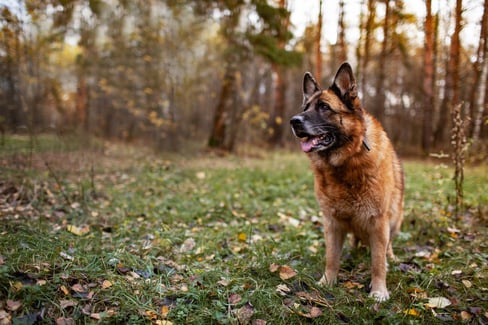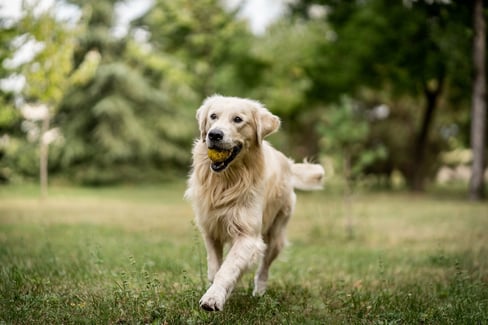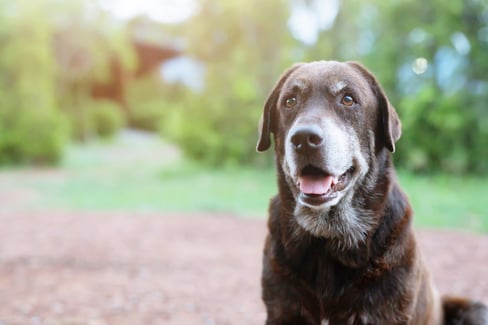Table of Contents
When you’re a pet parent, your pup is the center of your universe.
You love throwing around the frisbee, going for walks, and snuggling on the sofa at night.
But if you’re here, you might be noticing your dog isn’t enjoying those activities like they used to. They aren’t themselves, and you’re concerned.
Especially if you have a large breed, dog elbow dysplasia might be on your mind as a cause of this change in behaviour.
In this post, we’re going to go through the facts about dog elbow dysplasia, as well as share prevention and treatment options for your precious furball so they can get back to their old selves before you can say, “go fetch!”.
What is Dog Elbow Dysplasia?
Dog elbow dysplasia is a general term that describes abnormal elbow joint development in dogs. Most typically occurring in large breeds who grow quickly in puppyhood, elbow dysplasia describes a certain abnormal bone growth, cartilage development, and joint stress that affects your canine companion’s quality of life. It’s also one of the most common causes of osteoarthritis in dogs’ elbows.
So, in short, dog elbow dysplasia is a painful condition that impairs mobility in your pup and can even lead to lame dog symptoms.
But let’s back it up a little bit and talk about the makeup of your pup’s elbow so you can understand exactly how they can be impacted by dog elbow dysplasia.
Like in humans, your dog has three separate bones that make up the elbow joint — the radius, the ulna, and the humerus, as seen in the diagram below.
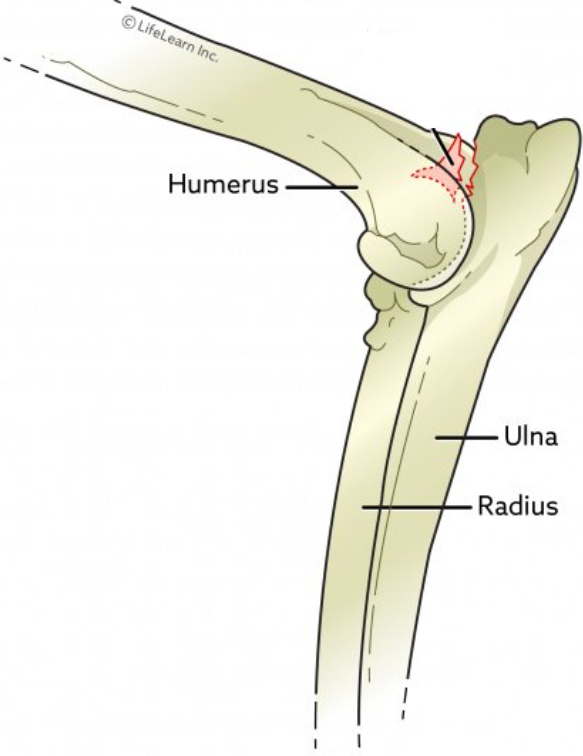
When your puppy is growing, especially if they grow too quickly, abnormalities can form and begin to give your dog trouble.
These abnormalities, known broadly as dog elbow dysplasia, can be categorized into four conditions:
- Medial coronoid disease
- Osteochondritis dissecans (OCD)
- Ununited anconeal process (UAP)
- Elbow incongruity
The diagram below shows where these specific conditions occur in the dog’s elbow:
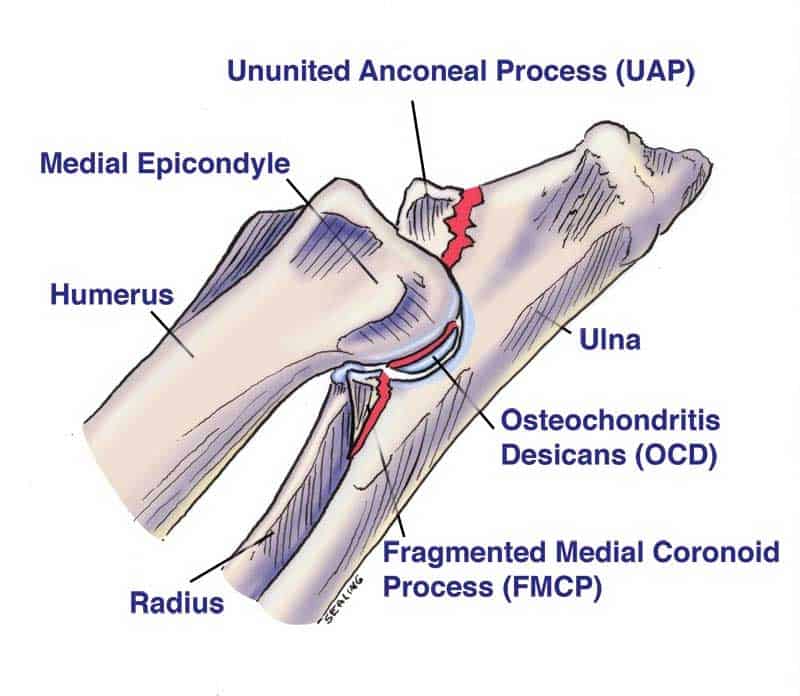
These terms can be confusing (not to mention a mouthful) so we broke them down in the table below so you can understand how each one can contribute to dog elbow dysplasia.
| Condition | Description |
| Fragmented Coronoid Process (FCP) |
|
| Osteochondritis Dissecans (OCD) |
|
| Ununited Anconeal Process (UAP) |
|
| Elbow Incongruity |
|
Dog Breeds Prone to Elbow Dysplasia

Like many conditions found in dogs, like hip dysplasia or luxating patellas, there are some dog breeds prone to elbow dysplasia more so than others.
Usually large, fast-growing dog breeds are most prone to elbow dysplasia, but that doesn’t mean that small dogs are safe from this disease either.
Specifically, dog breeds prone to elbow dysplasia include:
- Chow Chows
- Rottweiler
- Bernese Mountain Dogs
- German Shepards
- Australian Shepards
- Golden Retrievers
- Labradors
- Newfoundlanders
Genetic characteristics are a big contributing factor for dog breeds prone to elbow dysplasia, and without breeding the carriers of dog elbow dysplasia out, future generations are susceptible. Though, it has been found that parents with healthy elbow joints can still produce offspring that have elbow dysplasia. That is because some breeds, such as Chow Chows and Rottweilers, have greater prevalence and heritability of dog elbow dysplasia as a breed overall. Alternatively, breeds like the Australian Shepards don’t seem to produce as many affected puppies from normal parents.
The table below shows the prevalence of elbow dysplasia by breed and breed size.
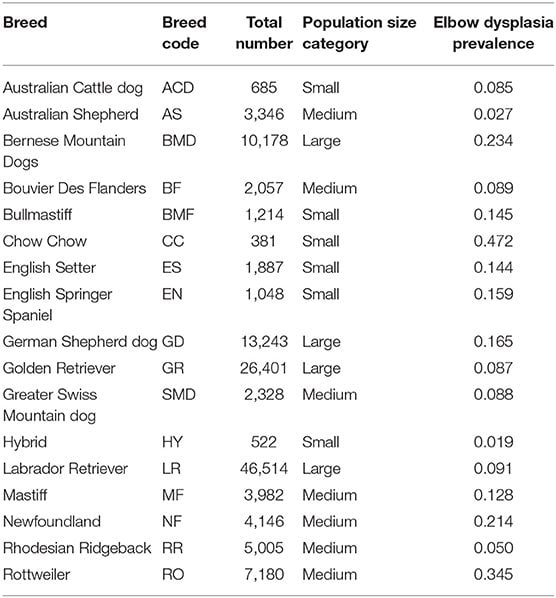
Elbow Dysplasia Dog Symptoms
The elbow joint is like any hinge. Not only is it a highly mobile joint, but it’s also a complex one, with bone and cartilage formed on both sides of the joint.
A small change in the shape of one part of the joint can have major consequences for the joint function, like a small piece of grit in a door hinge can stop it from opening or closing properly.
Each dog is unique, and no one knows them better than you. So when you see their behaviour change suddenly, it’s time to call the vet.
That being said, it can sometimes be tough to tell if your dog is suffering. There are common symptoms you can watch for that can give you a clue that your pup may be suffering from dog elbow dysplasia.
Elbow dysplasia dog symptoms can include the following:
- Sudden elbow lameness
- Less range of motion
- Sporadic lameness, specifically in forelimbs after activity
- Noticeable pain when they extend or flex the elbow
- Holding their affected limb away from the body
- Grating between joint and bone in advanced cases.
- Slow to rise from a laying down position
Elbow Dysplasia Dog: Diagnosis
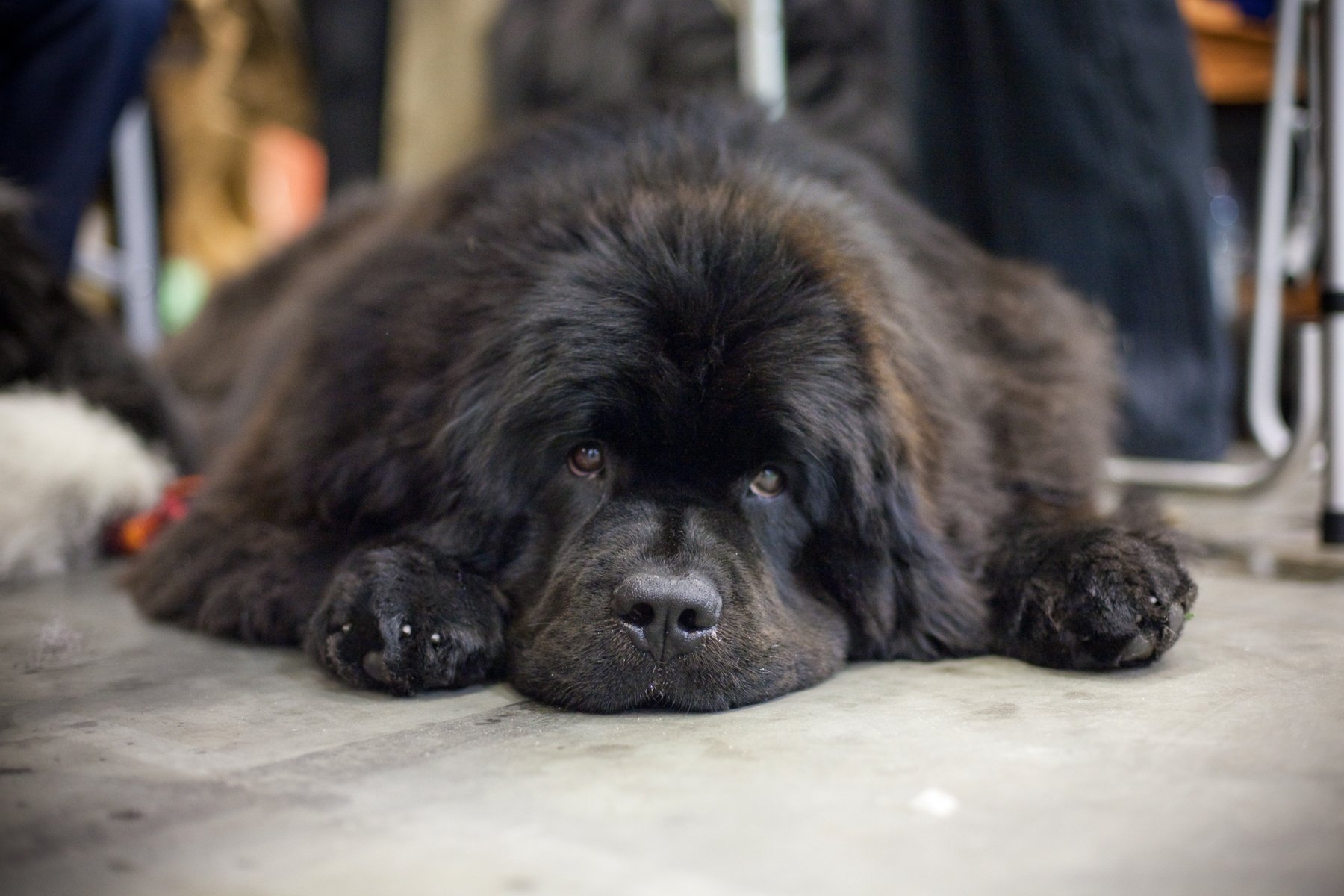
No one wants to see their pup in pain — they’re like family!
That’s why it’s important to get to the heart of the problem as soon as you can and get a dog elbow dysplasia diagnosis from your vet as soon as you can.
Since dog elbow dysplasia is a multifactorial disease, meaning it’s caused by multiple genetic and environmental factors, your dog needs to be assessed by a vet to properly get the diagnosis you need to move forward with proper care.
Getting a diagnosis will likely require a visual inspection but imaging will ultimately help get your dog the diagnosis they need.
There’s more than one option when it comes to diagnostic imaging for dog elbow dysplasia. In fact, there are 3 primary diagnostic techniques.
The table below outlines the techniques commonly used to diagnose dog elbow dysplasia.
| Diagnostic Technique for Dog Elbow Dysplasia | About Technique |
| Regular X-Ray |
|
| Computed Tomography (CT) Scan |
|
| Arthroscopy |
|
When your vet performs the diagnostic testing and imaging, they will also likely “grade” the severity of your dog’s condition based on the criteria established by OFA (Orthopedic Foundation for Animals).
Not the kind of grade you used to get in school, though.
This kind of grading is all about rating your dog’s elbow dysplasia from minimal to worst damage occurring on an anconeal process of the ulna (which is a growth on the back part of the elbow joint), measured in millimetres of bone proliferation.
There are three grades of dog elbow dysplasia:
- Grade 0 (no damage, normal elbow)
- Grade I (bone proliferation less than 2mm)
- Grade II (bone proliferation 2-5 mm)
- Grade III (bone proliferation greater than 5 mm)
Using this scale, your veterinarian will be able to determine the appropriate elbow dysplasia diagnosis, and how to proceed with your dog’s care.
Tips for Dog Elbow Dysplasia Prevention
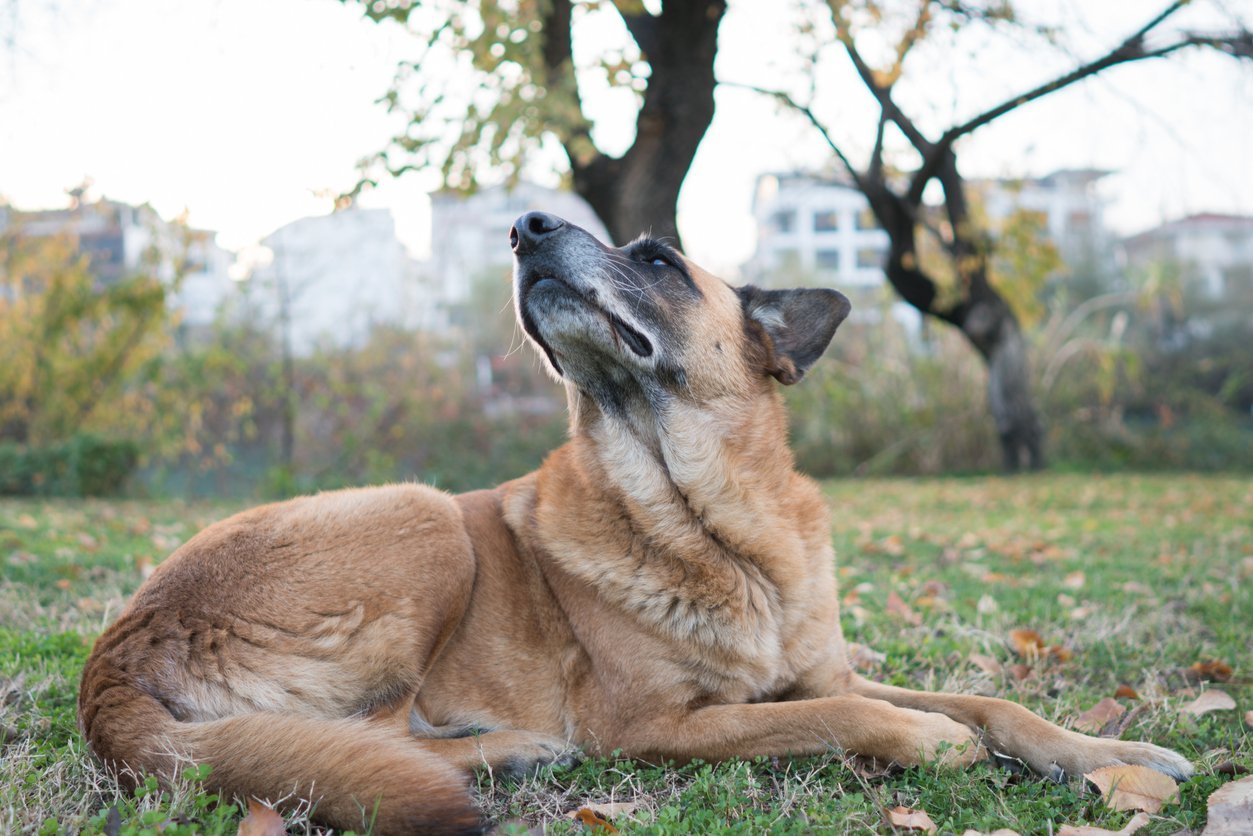
Sometimes, the best thing we can do for our pets’ health is to focus on prevention.
Sadly, there is nothing that can truly stop elbow dysplasia in dogs because it is a multifactorial disease.
However, you can make the right choices to manage symptoms and combat worsening joint health to prevent your pup from experiencing the painful effects of dog elbow dysplasia, so let’s get into those next.
Choose the Right Breeder
When you’re adopting a purebred pup, it can be crucial to know the family history.
All dogs can have genetic conditions passed through to the next generation but some dogs are more prone to receiving negative conditions than others. Purebreds especially can have genetic conditions that, if not bred out, can be passed on to future offspring.
That’s why it’s important to find a breeder that recognizes and uses the screening programs and guidelines from OFA and IEWG (International Elbow Working Group).
For many years, these two organizations have worked together to help pet owners screen for and prevent future instances of genetic conditions like dog elbow dysplasia.
They collect data from vets around the world and use it to help breeders remove affected dogs from the gene pool for future breeding. Dogs are typically scored or graded around 12 to 24 months old.
That way, you can be sure you’re doing the best job possible at avoiding dog elbow dysplasia, or at the very least working with an early diagnosis to keep your dog healthy and happy.
Balanced Nutrition

The more weight bearing down on your dog’s joints, the more stress that creates for the joint.
This is especially true for their elbow joints.
But don’t just take our word for it. Studies show that obese dogs with joint disease who lost weight were more likely to see improvements in their lameness and mobility. Ensuring your dog is getting just the right amount of exercise and nutrition can control their weight and give them a better leash on life.
Also important when it comes to nutrition is your dog’s diet during puppyhood.
When dogs get an excessive amount of nutrients (like calcium, for example) it can cause them to grow too quickly. When this happens, joints and bones may not line up properly, causing joint incongruence and discomfort for your pup. Excessive intake of nutrients can be caused by a variety of things, from overfeeding in general to the wrong kind of food for your pet’s needs. Either way, it has been shown to be detrimental to dog elbow dysplasia.
The right combination of nutrients, in the right amounts, can be beneficial to your dog’s growth — from coat right down to their joints, which brings us to the next section…
Dog Joint Supplements
We know we can’t 100% protect your dog from elbow dysplasia, but we can make sure they get the right support during their development by ensuring their joints form properly and their cartilage is as healthy as can be.
Adding a joint supplement during growth and maturation can do just that. TRI-ACTA Regular Strength is a great option for young and growing dogs to support proper joint development and ongoing mobility.
These key ingredients in particular help to prevent and manage the symptoms of elbow dysplasia:
- Glucosamine
- Chondroitin
- MSM
- Hyaluronic Acid (for more extreme cases)
By choosing a trusted joint supplement with 100% active ingredients, you’re aiding in the maintenance and health improvement of your dog’s cartilage, thereby helping improve or prevent the symptoms of elbow dysplasia.
TRI-ACTA for Pets
A proactive approach for developing and younger adult pets to maintain optimal joint health mobility, minimize inflammation and fend off age-related ailments.
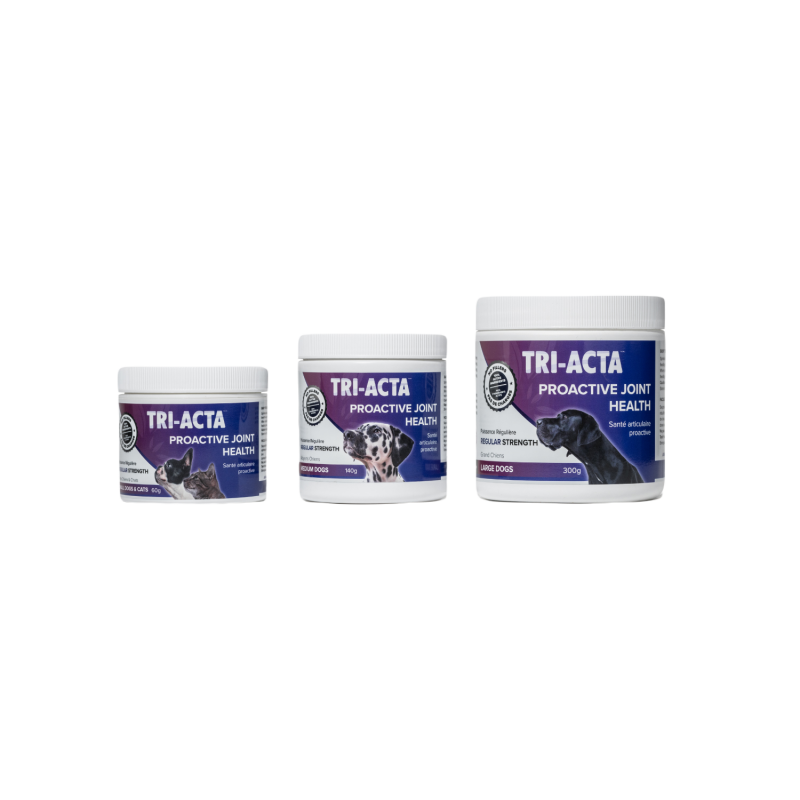
Injury Prevention
When you get hurt, it makes a lasting impact on your body.
The same is true for your dog! Especially while dogs are developing, it is important to prevent injuries to their joints. By reducing the trauma to your pup’s elbows, you can help improve their outlook and chances of developing dog elbow dysplasia.
As hard as it can be sometimes to contain your pup’s excitement when they’re playing or zooming around the house, avoiding hazards often created by those situations so your dog doesn’t suffer ligament strains and injury is important.
When your dog gets an injury, that trauma to the joint has a lasting impact. In the short term, it will cause swelling and inflammation at the site, but long term, it can contribute to the development of elbow dysplasia and canine arthritis.
Things that can cause unintended injury, especially when your dog is young, include:
- Slippery, hard surface floors
- Jumping on and off furniture
- Playing with toys like frisbees and balls thrown high in the air
- Off-leash play or walks
Sometimes, it can be difficult to prevent your dog from getting hurt. But preventing hazards, like putting area rugs on hardwood floors or avoiding throwing a ball or frisbee high in the air are just a couple of ways you can prevent the strains that can cause dog elbow dysplasia.
Controlled Exercise
Walking your dog that has elbow dysplasia might seem counterintuitive, but it’s important to keep your pup moving to ward off symptoms.
One of the things that will help the symptoms of dog elbow dysplasia is preventing excessive weight gain. That’s why the right amount of exercise is important to both keep their weight down, but also to make sure their muscles are in good shape and don’t atrophy.
Making sure light to moderate exercise is part of your dog’s daily routine will ensure that your joints will be supple and mobile. Generally, 15 to 20 minutes of exercise, twice a day, is ideal for most dogs. This is better than one long walk per day which can exacerbate injuries and dog elbow dysplasia.
Other more low-impact exercise options like swimming can be a great idea for improving your dog’s fitness without putting too much stress on their joints.
Dog Elbow Dysplasia Treatment Options
So all this information is great, but I know my dog has elbow dysplasia, now what?
If you’re asking yourself that question right about now, this next section is for you.
Here are the solutions for your elbow dysplasia dog so they can be more happy and comfortable as they age.
Rehabilitation
If there was an option for dog elbow dysplasia natural treatment, physical therapy and rehab are the closest things to it!
Like with our own physical therapy and injury recovery, dogs have a variety of options available to them to give them some much-needed pain relief and comfort, as well as build better joint health and muscle strength.
Some options for dog elbow dysplasia physical therapy include:
- Underwater treadmill walking
- Ultrasound therapy
- Electric stimulation
- Cold and heat therapies
- Massage
- Stretching and range of motion exercises
These techniques are designed to work together and independently of each other to relieve the pain your pup feels, as well as promote the overall health of their muscles and joints.
Dog Elbow Brace for Dysplasia
We bet you’ve seen someone in a sling or brace before, or maybe you’ve even been there yourself. These assistive devices are helpful for your pup too!
One of the more common supportive devices available on the market for pets is a simple dog elbow brace. It can be used on the front legs of the dog to essentially immobilize the joint and hold it in place while providing stabilization to the dog as they move.
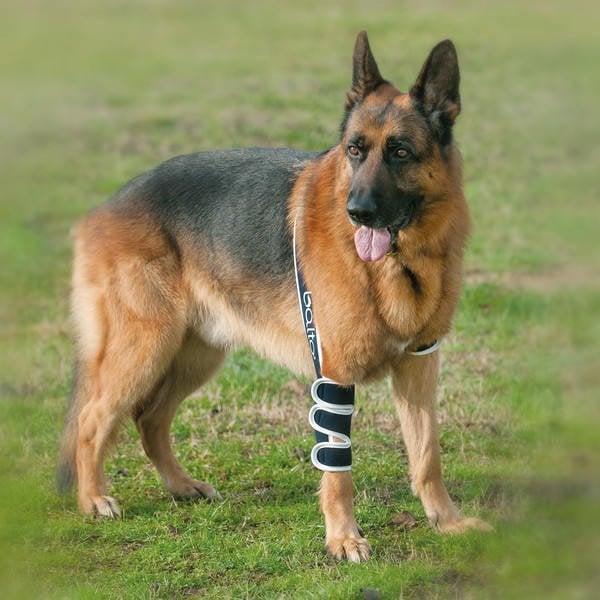
In milder cases of dog elbow dysplasia, the brace can be hinged to allow a more full range of motion in that particular limb. When you have a more progressive case of dog elbow dysplasia, you’ll likely need a rigid brace to prevent further injury.
Surgery
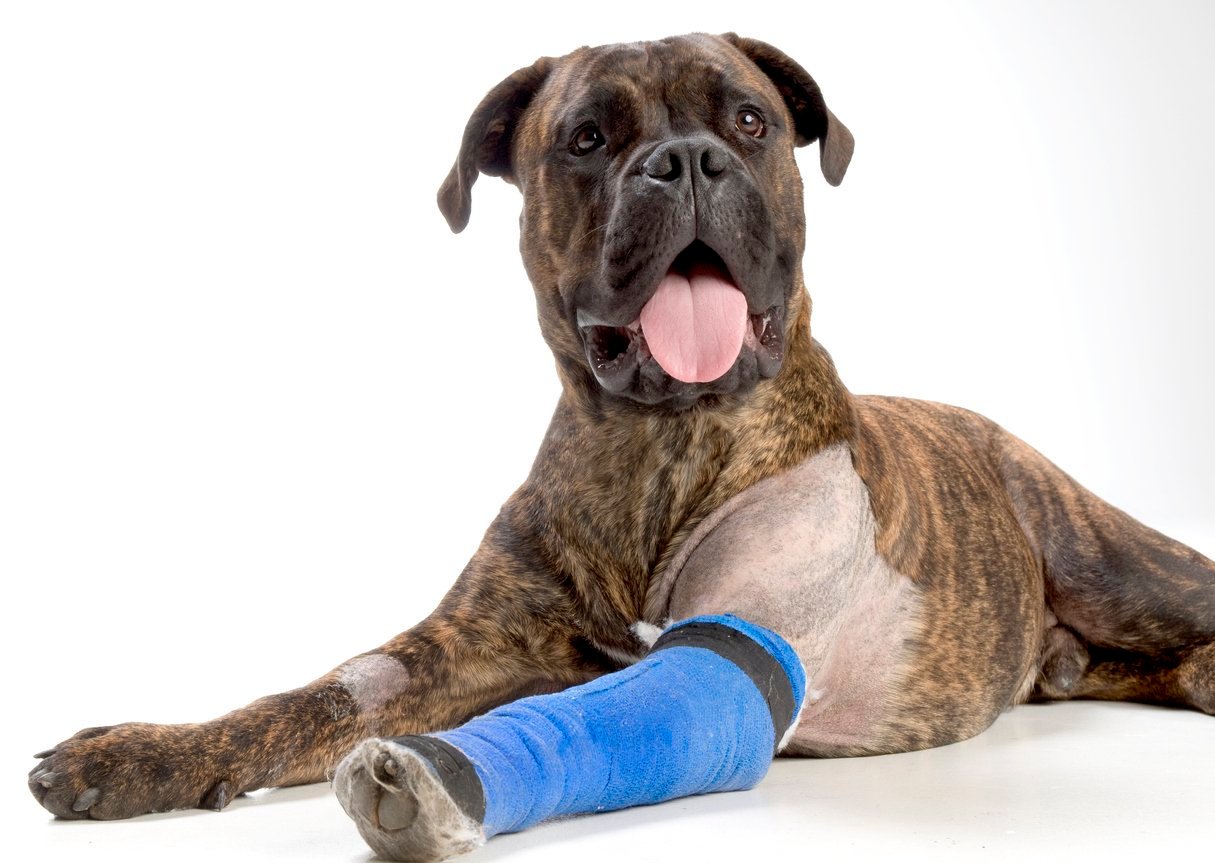
Sometimes, the option that is most likely to help your dog feel better is also the one that is most invasive.
While it may not be the first thing you consider when your elbow dysplasia dog diagnosis comes in, surgery should certainly be an option to consider when your pup is in severe, otherwise unmanageable pain and is suffering the worst of their symptoms.
This is usually when the joints have become damaged severely, and your pup is no longer getting the quality of life they deserve. can often reduce pain and improve mobility for your dog.
There are several different types of dog elbow dysplasia surgery out there:
| Type of Dog Elbow Dysplasia Surgery | About the Surgery |
| Fragment Removal |
|
| Incongruence Surgery |
|
| Salvage Surgery |
|
One big question that often lingers for pet parents once they hear about surgical options is how much will elbow dysplasia dog surgery cost them.
Well, as hard as it can be to pinpoint the exact elbow dysplasia dog surgery cost based on your dog’s specific needs as well as your location, it generally costs between $1,500 to $4,000 per elbow.
If your pup is recovering from surgery, you can help speed up the healing process and get back to their old selves a little sooner by adding an extra-strength joint supplement like TRI-ACTA H.A. to their diet. This helps reduce inflammation in the affected joint.
Pain Relief
One of the most common short-term solutions for making your dog more comfortable from dog elbow dysplasia pain is the use of NSAIDs, non-steroidal anti-inflammatory drugs, and joint supplements like TRI-ACTA H.A. for Pets.
These kinds of medications and supplements (unsurprisingly based on the names) are helpful at reducing inflammation and pain in the elbow joint. That can give your pet some quick relief from the pain associated with elbow dysplasia dog symptoms.
But be careful. Most vets will want to clear the use of NSAIDs for your specific pet by checking in on their renal function first to make sure it’s going to do more good than harm.
Some side effects of long term use of NSAIDs for managing dog elbow dysplasia can include:
- Vomiting
- Diarrhea
- Appetite loss
- Lethargy
The main thing is to always talk to your veterinarian about options for managing your pup’s pain levels, and never feed them any human supplements or medications because they are not meant for doggie consumption!
Joint Supplements
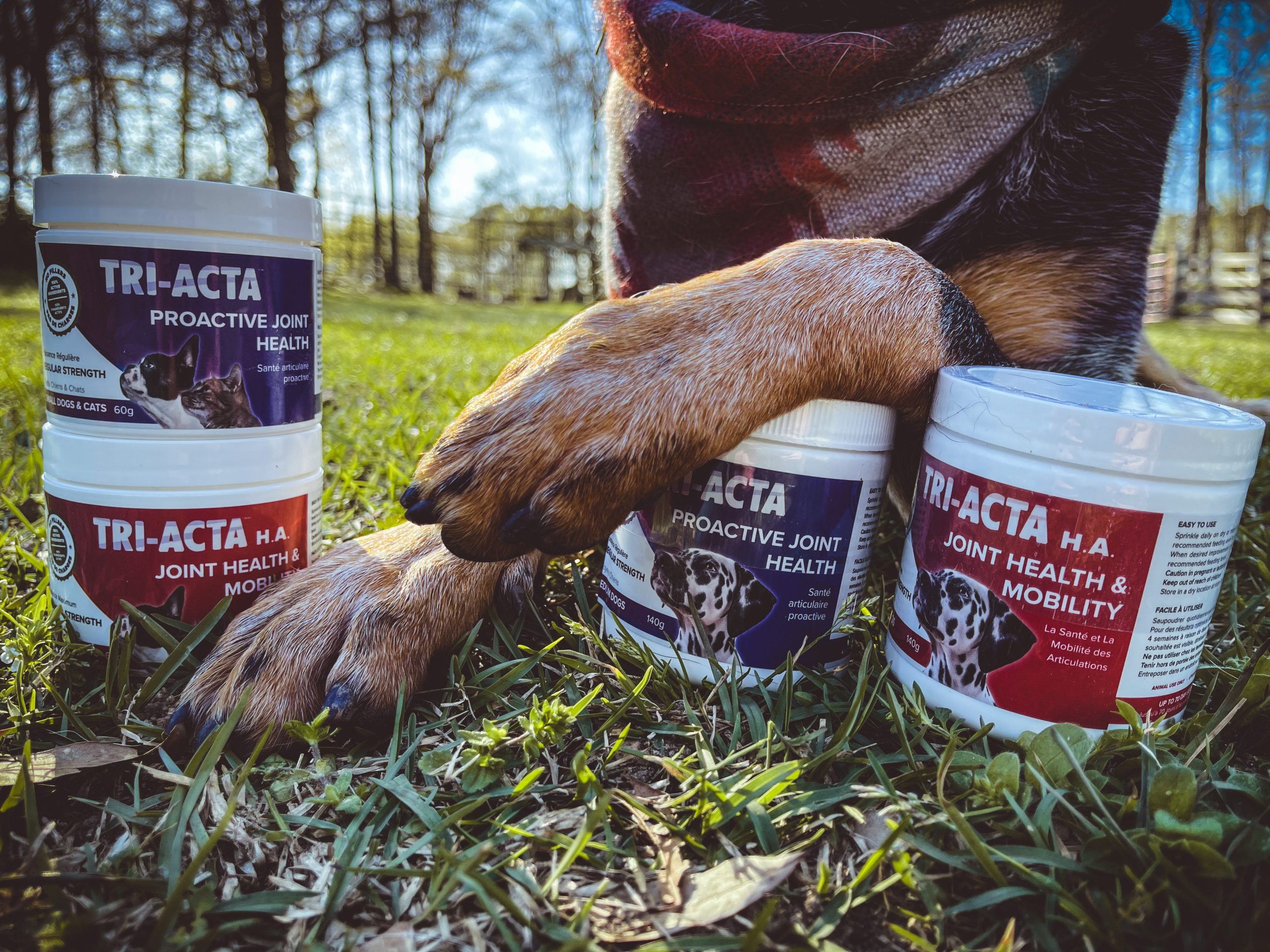
It should come as no surprise that we think joint supplements are both excellent preventative measures and curative solutions — they’re kind of our thing.
But that’s for a good reason.
Using a joint supplement allows you to give your dog the benefit of minimized pain, with the added benefit of helping their joints at the source.
Joint supplements like Integricare’s TRI-ACTA and TRI-ACTA H.A. offer protection of cartilage deterioration with the inclusion of glucosamine for dogs and other active ingredients, as outlined in the table below.
| Active Ingredient | Benefit |
| Glucosamine | Repairs and builds cartilage |
| Chondroitin | Prevents cartilage deterioration |
| MSM | Reduces pain and inflammation |
| Hyaluronic Acid | Helps with joint lubrication |
Recommended Dog Joint Supplements
Now that we know how important it can be to include a joint supplement for both preventative and curative purposes for dogs with elbow dysplasia, let’s talk about the best dog joint supplements out there!
1. Integricare TRI-ACTA H.A.
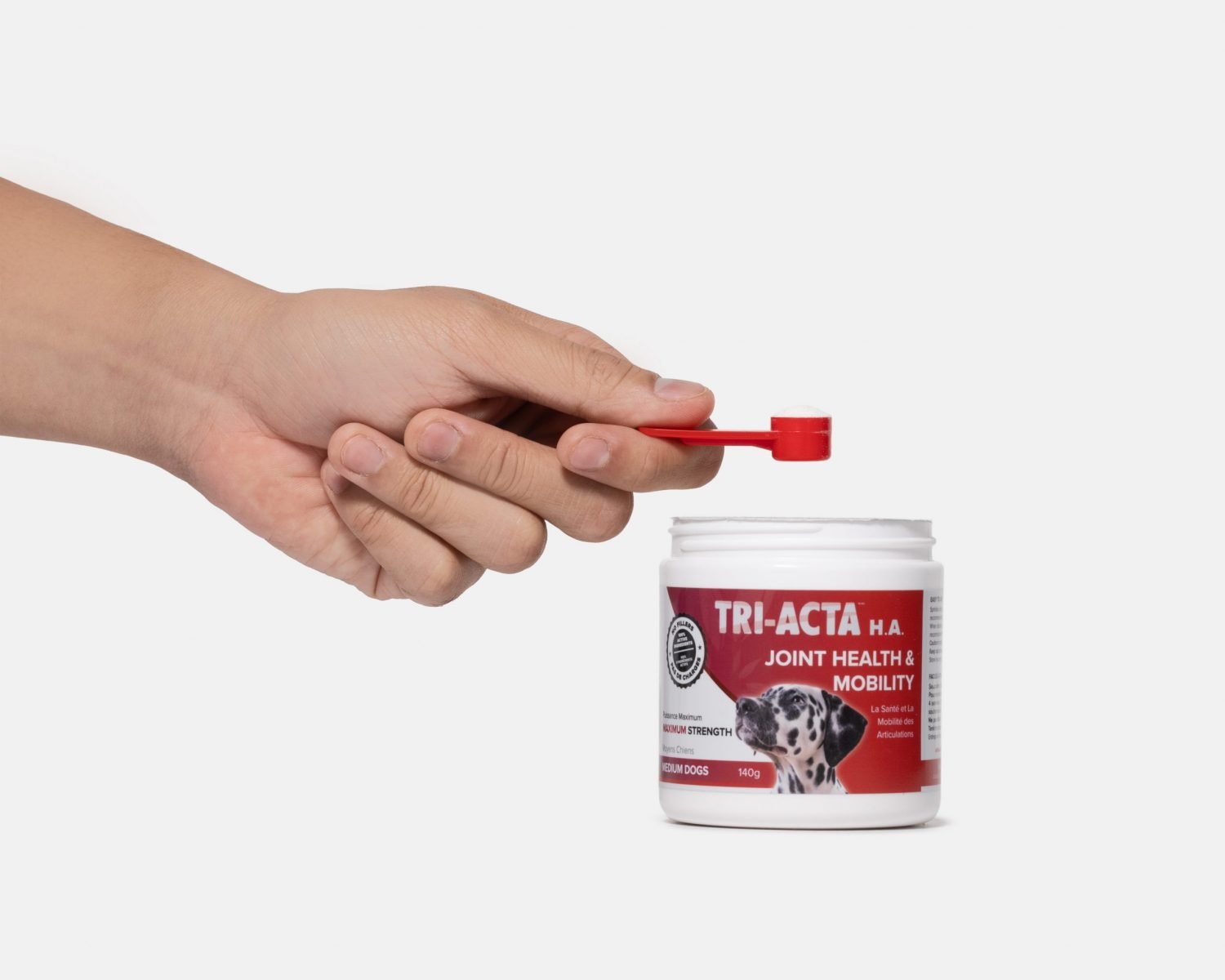
We couldn’t make a top three dog joint supplement list without including Integricare’s own formulations!
Our maximum strength counterpart to the regular TRI-ACTA blend, TRI-ACTA H.A. offers unmatched quality, efficacy, and therapeutic value.
Offering glucosamine, chondroitin, and MSM plus the addition of hyaluronic acid for added joint lubrication, TRI-ACTA H.A. can offer your dog with elbow dysplasia pain relief alongside the powerful cartilage protection and repair they need to live with this condition comfortably.
Plus, our formulations offer a small, easy to incorporate serving size packed with active ingredients. That’s a benefit for your pup (fewer palatability issues) and your wallet (less cost per serving without losing the therapeutic value).
* Priced $23.99 – $79.99 CAD as of January 2022
2. Infinite All-Natural Hip & Joint Powder Dog Supplement
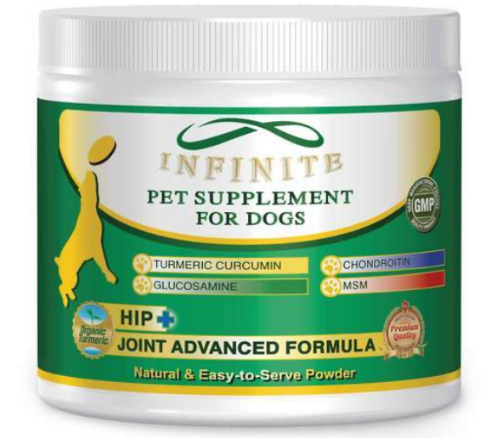
Finally, we have Infinite All-Natural Hip & Joint Powder Dog Supplement as another dog joint supplement option for your pup.
Just like our own TRI-ACTA options, this supplement is in an easy to serve powder format and it includes the active ingredients we like to see (glucosamine, chondroitin and MSM) as well as the bonus of turmeric for extra anti-inflammatory properties.
We also like that it’s made in a GMP-certified facility in the USA so you know your dog is consuming good quality ingredients and only good quality ingredients.
One drawback, similar to the last option, is that it’s missing that extra ingredient that packs a huge punch for fighting dog elbow dysplasia symptoms — hyaluronic acid.
* Priced $31.59 CAD as of January 2022
Get Started with Dog Elbow Dysplasia Prevention & Treatment
With all this information about dog elbow dysplasia in your back pocket, you can make the right decisions about handling your pup’s painful condition in the best way you can.
Between preventative measures and curative treatments, there’s one common thread linking them together — Integricare’s TRI-ACTA and TRI-ACTA H.A. joint supplements.
These power-packed supplements offer your elbow dysplasia dog reduced pain and inflammation as well as healing at the source with the inclusion of active ingredients like glucosamine, chondroitin, MSM and hyaluronic acid.
If you’re ready to help your pup feel better, you can find out where to buy our supplements here.
Newsletter Signup
Subscribe to our newsletter to receive the latest news and exclusive offers.
.jpg?height=2000&name=Cliick_Integricare-DISPLAY-REVISEDV2%20(1).jpg)
Proactive & Therapeutic Joint Supplements
When given daily, Integricare joint supplements recover bone and joint injuries faster and help prevent mobility injuries from happening in the first place.








